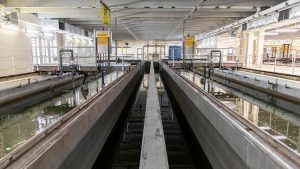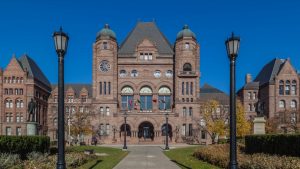Sept. 14 was a banner day for Ontario’s water and wastewater construction sector as the provincial government stepped up to announce new funding to supplement federal support previously earmarked for its new Clean Water and Wastewater Fund (CWWF).
The result is $1.1 billion in joint federal, provincial and municipal spending on 41 Ontario water and wastewater projects, news that thrilled Giovanni Cautillo, executive director of the Ontario Sewer and Watermain Construction Association (OSWCA).
The announcement was made by federal Minister of Infrastructure Amarjeet Sohi, provincial Minister of Infrastructure Bob Chiarelli and Toronto Mayor John Tory at Toronto’s Port Lands. The three levels of government will be spending $83 million on flood-protection measures in the area as part of the pre-development phase of the Port Lands.
Calling the news "fantastic," Cautillo said the provincial portion of the spending was "found money."
"It was not identified in the provincial budget," he said. "It was unallocated money. When we look at it, it is a windfall for the industry as a whole. It was previously unannounced spending, but they found $270 million.
"I don’t care where they found it, I am just happy they did." The federal government is providing up to 50 per cent of CWWF funding, amounting to almost $570 million, while the provincial government will spend almost $270 million. Municipalities, First Nations and local services boards will cover the remaining costs, a provincial media statement indicated. Municipalities will be able to apply Ontario Community Infrastructure Fund grants toward the municipal contribution for the projects.
The CWWF budget was announced at $2 billion in total when it was unveiled this spring.
"We knew that the federal money had arrived, because that money was announced previously this year," Cautillo said. "The process by which municipalities could apply for the money was still very muddled. And they knew that there was going to be some sort of agreement with the province but there has to be a cost-sharing agreement with the province, so when they were able to finalize the cost-sharing agreement, that’s where this came out of."
While the Port Lands spend is by far the biggest single project identified for CWWF money, it’s the only Greater Toronto Area initiative in the package. Barrie received funding for five separate projects, Guelph three, Brampton 10, the Region of Waterloo four and Sudbury 17.
Shovel readiness was a major factor of the Phase 1 federal infrastructure program, Cautillo noted, in that the projects have to be underway by the end of 2018.
Cautillo said the funding means that the message is reaching the upper tiers of government that the water and wastewater infrastructure gap can no longer be ignored. Increased flooding in recent years attributable to climate change that has shut down communities and sometimes caused bypasses of sewage treatment plants has got politicians’ attention, he suggested.
"They’re taking notice," Cautillo said. "My biggest thing is, when you start talking about raw sewage, it’s disgusting. Yet it is in your main source of drinking water. Are you not appalled by this?"
Some of the Brampton funding will be spent on identifying areas where increased storm sewer capacity is required for present and future development, said a statement issued locally. Brampton Mayor Linda Jeffrey said the allocations will "assist us in solving flooding challenges caused by climate change."
Cautillo said he believes OSWCA lobbying played a role in convincing the province to take action. The association commissioned a report titled Bringing Sustainability to Ontario’s Water System that was released in conjunction with a blitz on Queen’s Park in May.
"This ties into our lobby day efforts," he said. "We impressed on the provincial government that they had to mimic what they had on the federal level, which is the Clean Water and Wastewater Fund. I said, it only makes sense to have it on the provincial level in order to close the gap."
Both Sohi and Chiarelli come from municipal governments, Cautillo noted, meaning they understand the history of underfunding water and wastewater projects.
"I applaud them on their foresight," he said. "They viewed this from the grassroots level and a top-down level."
Cautillo said he hopes more funding, reflecting a longer-term horizon, will emerge as the federal government announces its Phase 2 of infrastructure funding. The long-term goal is to ensure municipalities all move to "full-cost pricing," he said, with the costs of water and wastewater services fully accounted for in consumer pricing and the system treated like a utility.
"That’s where the asset pays for itself based on user fees," he explained. "The utility model. You pay for what you use."
Even flood protection spending can be viewed this way, he said.
"That is a benefit to the constituent," said Cautillo. "You can turn around to the constituents and say, I have to increase water and wastewater bills in order to protect you from the type of flood that occurred in 2013."





Recent Comments
comments for this post are closed